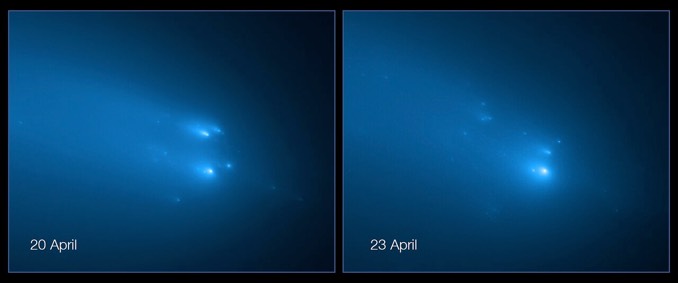
Hopes that comet C/2019 Y4, known more widely as ATLAS, might brighten to naked eye visibility as it neared the sun were dashed when it began dimming and amateur astronomer Jose de Queiroz confirmed the body was fragmenting. Now, the Hubble Space Telescope has captured two images showing Atlas, originally up to 180 metres (600 feet) across, has broken into as many as 30 pieces, each about the size of a house.
“Their appearance changes substantially between the two days, so much so that it’s quite difficult to connect the dots,” said David Jewitt, professor of planetary science and astronomy at the University of California Los Angeles and leader of a team observing the comet with Hubble.
“I don’t know whether this is because the individual pieces are flashing on and off as they reflect sunlight, acting like twinkling lights on a Christmas tree, or because different fragments appear on different days.”
Comet fragmentation appears to be relatively common, but because such events happen quickly and unpredictably, it’s not yet known if it might be a dominant mechanism. Hubble’s images of Atlas may help resolve the mystery and shed light on whether the comet spun itself apart due to jets from sublimating ice.
“This is really exciting, both because such events are super cool to watch and because they do not happen very often,” said Quanzhi Ye, leader of a second team using Hubble at the University of Maryland. “Most comets that fragment are too dim to see. Events at such scale only happen once or twice a decade.”
Comet ATLAS was discovered 29 December 2019 by the Asteroid Terrestrial-impact Last Alert Systems – ATLAS. Falling toward the inner solar system, it is currently located inside the orbit of Mars. What’s left of the comet will pass within about 115 million kilometres of Earth on 23 May before sweeping past the Sun on 31 May



